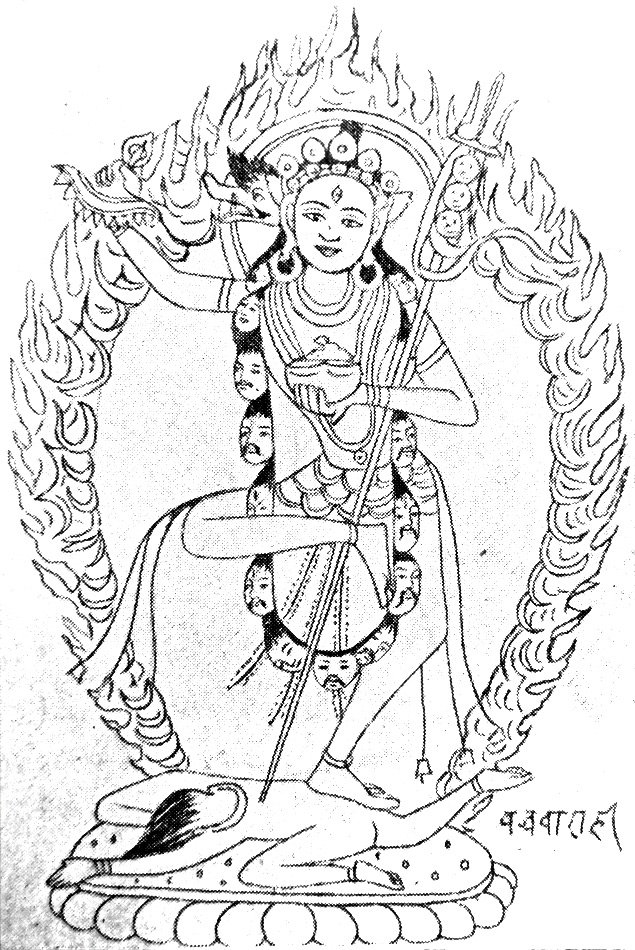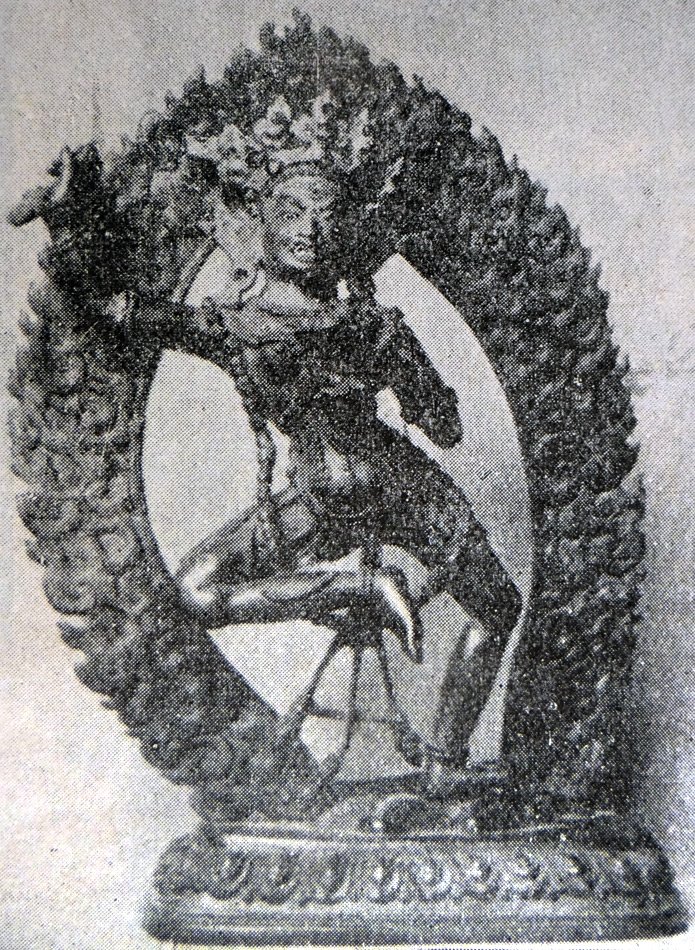The Indian Buddhist Iconography
by Benoytosh Bhattachacharyya | 1958 | 51,392 words | ISBN-10: 8173053138 | ISBN-13: 9788173053139
This page contains an iconography image of Emanations of Vairocana: Vajravarahi and represents figure 159-160 of the book Indian Buddhist Iconography, based on extracts of the Sadhanamala English translation. These plates and illustrations represent either photographs of sculptures or line-drawing reproductions of paintings or other representations of Buddhist artwork.
Figure 159-160 - Emanations of Vairocana: Vajravārāhī
 Fig. 159: Vajravārāhī |
 Fig. 160: Vajravārāhī (Baroda Museum) |
Characteristic feature: excrescence near the right ear.
The union of Vajravārāhī with Heruka is the cult of the celebrated Cakrasaṃvara Tantra. One of the Sādhanas gives her the epithet of “Śrī Herukadevasyāgramahiṣī” or “the first queen of the god Śrī-Heruka”. She is also called a Ḍākinī and in the Buddhist Tantra this signifies any Śakti with whom the Yuganaddha (yab-yum) worship may be performed. It will not be out of place to mention here that Heruka is also associated with Vajrayoginī and then union is the subject of the great Heruka Tantra, but Vajravārāhī differs considerably from Vajrayoginī in form. If Vajravārāhī is the first queen of Heruka, there is no reason to suppose that Vajrayoginī may not be another. In fact, it has already been shown that Heruka in yab-yum form used to be associated with other goddesses, such as Nairātmā [?] and Vajraśṛṅkhalā, as well. Vajravārāhī is represented as nude and as displaying intense and passionate love.
The name Vajravārāhī or ‘adamantine sow’ is given to her for the simple reason that she has an excrescence near her right ear which resembles the face of a sow. It is far more likely that Getty's story about Yun-gar’s attack on the abbess and the monastery refers to Vajravārāhī than to Mārīcī; for while Mārīcī has one face which may be distorted sow-like, Vajravārāhī has a natural excrescence just near the right ear, which has gained for her the epithet ‘Vajraghoṇā’ in the Sādhanas, Another argument in favour of this is that, while Vajravārāhī is called a Ḍākinī, and is associated with four other Ḍāknīs, she may quite easily be an abbess, and therefore, a Siddha woman deified, and not a goddess. But Mārīcī is decidedly a goddess ; she is Vajradhātvīśvarī and the consort of a Dhyāni Buddha.
Several Sādhanas, both long and short, describe two distinct forms of Vajravārāhī. who is also known as Buddhaḍākinī and Vajravairocanī. She is either two-armed or four-armed. Even when two-armed she may have several forms according to weapons she carries in her two hands. In one Sādhana only is she said to emanate from the family of Vairocana, and bear the double Vajra on her head, but the others are silent as to her sire.
Images of this very popular goddess are found in Tibet and China.
(I) Vajravārāhī:
Colour: red;
Appearance: nude;
Arms: two;
Āsana: pratyālīḍha;
Symbols: vajra-tarjanī and kapāla.
Several Sādhanas in the Sādhanamālā describe two-armed forms of Vajravārāhī. [...]
The Sādhana further adds that the four petals of the lotus on which she stands are occupied by the four goddesses Ḍākinī, Lāmā, Khaṇḍarohā and Rūpiṇī in the four cardinal directions beginning from the right. The four companions are of blue, green, red and white colour respectively, and they are all one-faced and four-armed. They all carry the Khaṭvaṅga, the Kapāla in the left hands and the Ḍamaru and the Kartri in the two right hands.
(II) Vāsya-Vajravārāhī:
Symbols kartri and kapāla;
Āsana: dancing in ardhaparyaṅka;
Vāhana Corpse lying on back.
This form of Vajravārāhī is invoked in those rituals which are performed with the specific purpose of bewitching men and women, and is very popular in Nepal and other Buddhist countries. This form is almost identical with the one described above with the difference that here the goddess wields the Kartri in the right hand instead of the Vajra, along with the raised index finger. The left has the Kapāla like the previous one. The Khaṭvaṅga as usual hangs from her left shoulder just as it is seen in the Heruka and Nairātmā images. She stands in the attitude of dancing in Ardhaparyaṅka on a corpse instead of showing the Pratyālīḍha as in the previous case.
Fig. 159 illustrates a Nepalese drawing of the goddess. A beautiful statutre of Vajravārāhī is preserved in the Baroda Museum (Fig. 160).
(III) Ārya-Vajravārāhī:
Appearance: terrible;
Āsana: ālīḍha;
Arms: four.
The four-armed form of Vajravārāhī is also similar to the forms mentioned before, and is called Ārya-Vajravārāhī. The difference lies only in the attitude, number of arms, and the symbols carried in her hands. She carries in the two right hands the Vajra and the goad, and in the two left the Kapāla and the Tarjanī with the noose. She is one-faced and three-eyed, and appears terrible with contortions of eye-brows, the adamantine excrescence, and the protruding tongue, teeth and belly. She stands in the ālīḍha attitude on the corpse, unlike the other forms of Vajravārāhī. The Khaṭvaṅga hangs from her left shoulder as usual.
